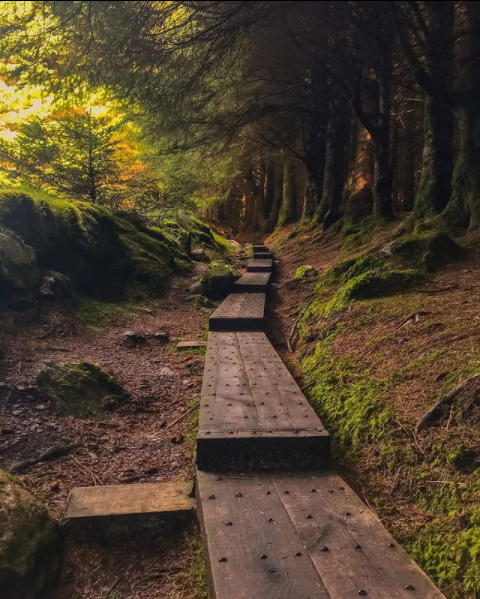The Wicklow Way is my favourite long distance trail in Ireland. It was first written about in the mid-1960s by J.B Malone who set out to develop a long distance walk in Ireland. It took many years for this idea to gain much interest. The Wicklow Way is now the best known hiking trail in the country and easily accessible from Dublin.
Stretching from Marley Park in Dublin to Clonegal in Carlow, the Wicklow Way is approx 125km and split into seven “stages”. Each stage is intersected by a small town. Most hikers take up to one week to complete the trail without having to rush. In between these towns, the trail can feel surprisingly remote. It snakes its way through a series of foothills and mountains that climb more than 3,500 metres in total.
Hiking the Wicklow Way: What Should You Expect?
Most of the trail travels through Wicklow which mostly consists of mountains and hills. You will also hike stretches of paved road from time to time. These are usually quiet country roads and lanes with little-to-no traffic. It’s relatively easy to find a water source on most days (but not guaranteed). The accommodation at the end of each stage is reasonably affordable and cheerful. If you wish to wild camp, this is also possible – but more on this in a moment.
Overall, I’m always surprised with how remote it can feel on the Wicklow Way because you are always within walking distance of civilization. While the hill climbs come and go by the hour, they are rarely too steep and are accompanied by stunning views. The Wicklow Way is also well-marked and with a paper map and GPS, I believe most hikers will feel comfortable in terms of navigation. With these stunning views and favourable logistics, I think it’s an ideal long distance trail for a first-timer.
But maybe you don’t want to (or cannot) hike the full Wicklow Way?
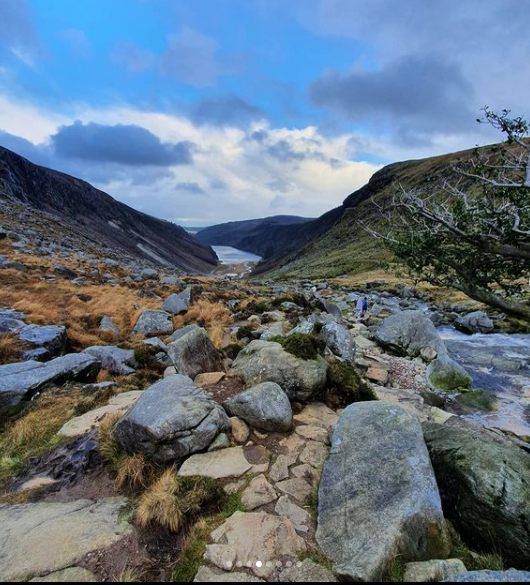
Hiking the Wicklow Way in Stages
It’s also possible to hike the Wicklow Way in stages. This makes the trail suitable for every fitness level. Some stages are much shorter than others so hikers can also pick out a specific stage, with which they feel comfortable. I’ve done this myself when short on time and if you live in Dublin, County Wicklow never feels like “a long way to go” for a hike.
What’s the Best Time of Year to Hike the Wicklow Way?
May to September is the most reliable time to hike the Wicklow Way. I would advise the less experienced not to attempt this trail close to the Winter months. Most of the accommodation (and many restaurants) are also not open outside of the Summer months. The weather is very unpredictable which is the main reason to avoid these months. In fact, I prefer to hike this trail in the shoulder months of May or September. There are less people on the trail and various attractions in between are less busy.
In case you might be asking yourself, I refer to places like Powerscourt Waterfall and Glendalough which are both highlights of hiking the Wicklow Way.
Where to Start and Finish the Wicklow Way
I should also say that you can choose to hike north to south or south to north. The main difference between each starting point is the ease of transport. That is to say, it’s easy to get to/from Marlay Park in Dublin but slightly more tricky to reach Clonegal.
There’s also the fact that starting in Clonegal will help ease you into the hike. Less climbs near the beginning when you hike south to north. While the last day presents stunning views of Dublin and the coastline.
Note: The number 16 bus travels from Dublin city centre to Marlay Park. Meanwhile, Bus Eireann stops in Kildavin which is less than 3km from Clonegal.
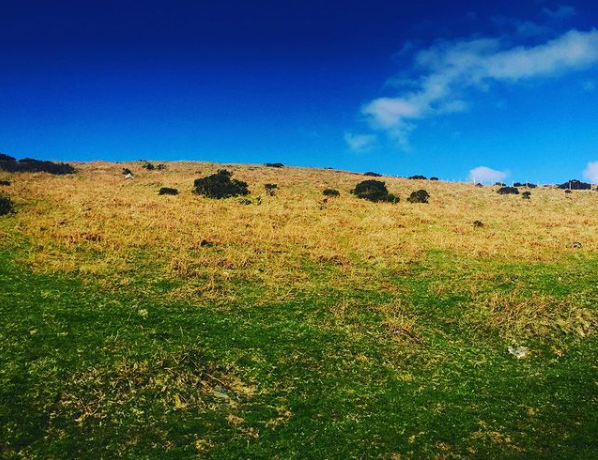
Wild Camping Vs. B&B – Where to Stay in the Wicklow Way
As for where to stay, there are B&B’s at the end of each stage on the Wicklow Way and a handful more in between. There is a nice little hostel in Knockree and another at Glendalough and three Adirondack Shelters on the trail. These shelters are small huts that were built so that hikers could take shelter from the elements. I’ve come across people wild camping beside these shelters and sleeping inside with a bivvy bag. With one or two exceptions I’ve found multiple spots to wild camp on the Wicklow Way.
You should know that wild camping is not permitted in Glendalough Valley. Hikers should always expect to either camp earlier than planned or to hike further when searching for a suitable spot. I say this because sometimes you happen across a suitable spot for a wild camp but it might be earlier than you expected to stop hiking. Likewise, it’s often necessary to keep hiking until you find a nice place to wild camp.
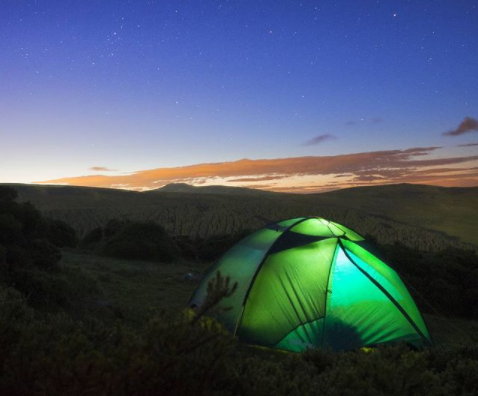
Food and Water on the Wicklow Way
It’s important to carry enough food for each stage of the Wicklow Way because towns are few and far apart. There is no alternative to these towns in terms of buying food. As for water, there are many sources along the trail. There are also times when you might not come across one when needed. You should have at least two or three litres of water at all times. Remember that due to wildlife, farming and forestry, the water en-route is not always potable. With this in mind, it’s really important to pick up a water filter like the Trailshot Microilter by MSR.
For my own hikes, I always had at least one backup meal in dried food for each time of day – breakfast, lunch and dinner. I also pack many cereal bars and snacks in the case of an emergency (running out of food).
Following the Trail Signs and Navigation on the Wicklow Way
The Wicklow Way is sign-posted really well with a variety of markers that feature a “yellow man”. You will most often find them at junctions and then every half-kilometre for the long straight sections on the trail. There are also information boards from time to time but it’s best to have your own GPS, maps and apps to consult for navigation.
As a rule, if you don’t see a trail marker for more than one kilometre, it’s possible that you will need to turn around and at least check your map. I’ve mostly used offline maps (an app downloaded before hitting the trail) but in the case of my battery running out, I also have a powerbank and OS paper map of the Wicklow Way area.
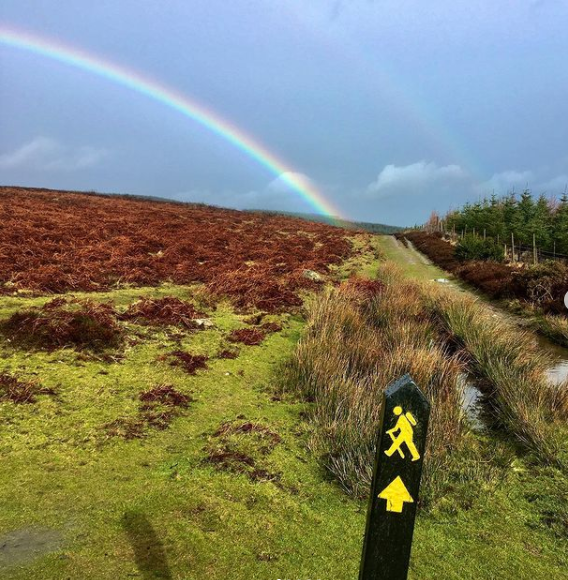
What Gear to Pack for the Wicklow Way
I’ve put together this packing list for a long distance hike which you might want to check out. It’s crucial that you also do your own due-diligence. The gear you pack will always impact how comfortable and safe you feel on the Wicklow Way. Footwear with good outsoles and support is recommended. I always use trekking poles – the importance of which many hikers seem to ignore. I won’t go into the specifics in this post but I would like to mention a few things to remember about clothing:
Layering Up – The weather on the Wicklow Way can change in a second and you need to be prepared for cold or wet weather on a hike. While it may seem like a sensible idea to take the warmest, waterproof jacket with you – the better option is to layer up. If you have both lightweight gear and several layers for underneath, this will enable you to regulate your temperature and provide you with the best of both worlds.
Avoid Cotton – When the weather is hot, cotton can cause chaffing. When the weather is wet, cotton is difficult to dry. When you are cold, wet, and wearing cotton, you are a walking recipe for hypothermia. Choose a material like merino wool, polyester or nylon which dries quickly and keeps the moisture off your skin.
Keeping Clothing Dry – It always brings me confidence to know that there is something warm and dry to wear later that night. Also, if you wake up to the sound of rain in the morning and your hiking gear is wet, resist the temptation to hike in your dry clothes. Instead, pack them up, put on the wet gear and suck it up. You’ll likely need this warm and dry gear to sleep in again that same night.

Day by Day Itinerary for Hiking the Wicklow Way
Let’s take a quick look at the seven stages from north to south on the Wicklow Way:
Marley Park to Knockree – 21km – Approx 8 hours walking.
Knockree to Roundwood – 18km – Approx 7 hours walking.
Roundwood to Glendalough – 12km – Approx 4 hours walking.
Glendalough to Aughavannagh – 14km – Approx 5 hours walking.
Glendalough to Glenmalure – 14km – Approx 5 hours walking.
Glenmalure to Moyne – 21km – Approx 7 hours walking.
Moyne to Shillelagh – 21km – Approx 7 hours walking.
Shillelagh to Clonegal – 19km – Approx 6 hours walking.
Some Final Points for Hiking the Wicklow Way
Carrying Your Own Backpack – Believe it or not, you don’t even need to carry all your belongings in the summer months. It’s possible to ask most B&B’s or even a local transport company to take your backpack to the next town – for a fee of course.
Consult the Weather Forecast – The Wicklow mountains are very exposed in places and rather scary in extreme weather. The weather can also change very quickly so it’s important to have an idea of what to expect and plan and pack accordingly.
Bring a Powerbank – Try to make sure that both your phone and powerbank is full charged by the time you depart each morning. Charging these items is the first thing I try to do as soon as I stop hiking for the day.
Be Careful on the Roads – Although there is little traffic on the road sections, cars can drive fast on these sections for this same reason which poses an obvious danger.
Remember to Leave no Trace – Know the principles of “Leave No Trace” and always pack out everything that you take with you on the trail. It’s also really important to respect the wildlife and local landowners and avoid starting any campfires.
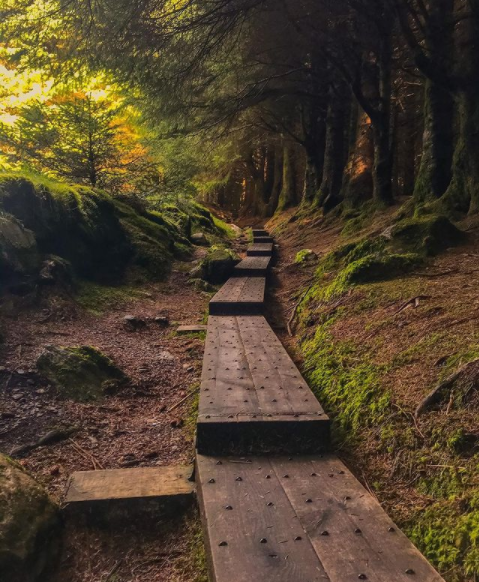
Final Thoughts
You don’t need to have a high level of fitness to hike the Wicklow Way but decent preparation will always keep you safe. Early starts will also help take the pressure off in terms of covering any distances in between. I also encourage friends or family to hike the Wicklow Way alone. Yes, you can share the cost of accommodation with friends but hiking alone is a very different experience and the Wicklow Way is the perfect opportunity to experience a stunning wilderness in the “Garden of Ireland”.

